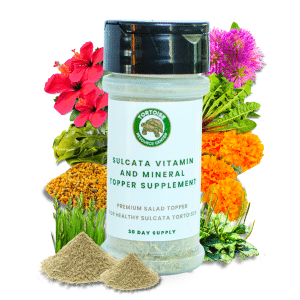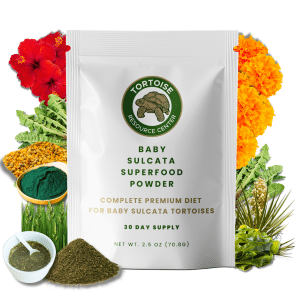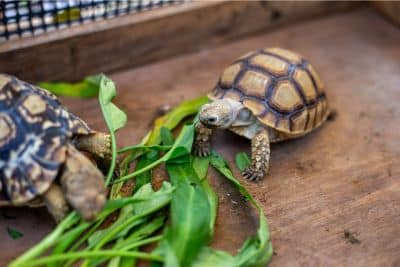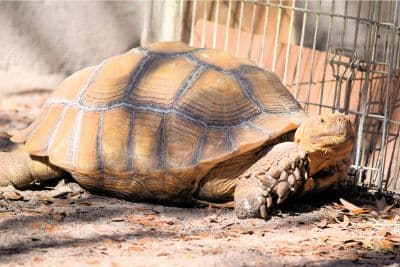Leopard tortoise temperature requirements are critical to digestion, immunity, and long-term health, making proper heat management one of the most important parts of their care.
Leopard tortoises (Stigmochelys pardalis) are some of the most interesting tortoises in the world, and they’ve only grown more and more popular with chelonian enthusiasts over time. But while these massive tortoises can make fantastic pets for the right owners, they have several basic needs that keepers must satisfy.
Among the most important husbandry duties are Leopard tortoise temperature and humidity requirements. To help set you and your new tortoise up for success, I’ve outlined the parameters for each below.
The Leopard Tortoise: Natural Habitat & Climate Conditions
Like all reptiles, leopard tortoises require temperature and humidity levels that generally resemble those of their native lands.
However, leopard tortoises exist across a vast range, encompassing most of southern and eastern Africa, from South Africa, north to Ethiopia, Sudan, and Somalia, and west to the Atlantic Ocean. Across this enormous range, they experience quite a variety of environmental conditions, as a species.
Nevertheless, most areas within the leopard tortoise’s range are relatively warm, though they fluctuate significantly across the calendar year.
Below, you’ll find some of the climate averages for three different cities within different portions of the leopard tortoise’s range.
Climate of Birni-N’Konni, Nigeria
Like most other portions of the leopard tortoise’s range, Birni-N’Konni is quite warm. It is also dry throughout most of the year, with several months receiving essentially no precipitation. What little rain does fall in this region tends to occur between July and September.
- July temperatures typically fall between 76- and 95-degrees Fahrenheit
- January temperatures typically fall between 63- and 91-degrees Fahrenheit
- July precipitation averages 5.41 inches
- January precipitation averages 0.00 inches
- Humidity levels in July average 65%
- Humidity levels in January average 21%
Climate of Luanda, Angola
Luanda is cooler than many other portions of Angola, as it’s located close to the coast. However, despite being close to the coast, this region is incredibly dry and receives only about 16 inches of precipitation per year; from May to October, rainfall is almost non-existent.
- July temperatures typically fall between 67- and 78-degrees Fahrenheit
- January temperatures typically fall between 76- and 88-degrees Fahrenheit
- July precipitation averages 0.42 inches
- January precipitation averages 2.06 inches
- Humidity levels in July average 80%
- Humidity levels in January average 76%
Climate of Upington, South Africa
At approximately 2,700 feet above sea level, Upington is relatively comfortable (for humans) by South African standards. Note that the region’s seasons are inverted with respect to those in the USA, with July being one of the coolest months and January being among the hottest. This region only receives a bit more than 8 inches of precipitation each year; March is the wettest month, while August is the driest.
- July temperatures typically fall between 39- and 73-degrees Fahrenheit
- January temperatures typically fall between 68- and 99-degrees Fahrenheit
- July precipitation averages 0.14 inches
- January precipitation averages 1.68 inches
- Humidity levels in July average 41%
- Humidity levels in January average 32%
Temperature Requirements for Leopard Tortoises
Now that you understand what some of the typical temperatures are within the leopard tortoise’s natural range, you can begin extrapolating that information to devise a suitable thermal environment for your pet. However, before getting into the specific temperatures you want to provide your leopard tortoise, it is important to understand a critical component of reptile husbandry: establishing a thermal gradient.
Simply put, providing a thermal gradient means offering your pet a range of temperatures within the enclosure. This allows the animal to adjust his temperature by moving throughout the enclosure, instead of being forced to accept whatever temperature you provide.
You can accomplish this by placing all of the heating devices (be they heat lamps, radiant heat panels, or some other heating device) at one side of the habitat. This creates a “basking spot” beneath the heating devices, with temperatures that fall with increasing distance from the heating devices.
When caring for leopard tortoises, you’ll want the temperatures at the basking spot to be between 90- and 100-degrees Fahrenheit. The opposite end of the enclosure (the “cool” side) should have temperatures in the mid-70s. At night, the temperatures can be allowed to drop into the mid-60s.
Just note that these temperatures are appropriate for adult leopard tortoises; young individuals will need slightly different temperatures. Hatchlings and juveniles only need a basking spot of approximately 90 degrees, and the cool side of the enclosure should be the high-70s. Additionally, you’ll want to prevent the temperatures from falling below the 70-degree mark at night.
Proper Humidity Levels for Leopard Tortoises
As you may have noticed when reviewing the climate data provided earlier, the relative humidity level varies widely across the leopard tortoise’s range. This helps demonstrate an important fact about these tortoises: They’re quite adaptable in terms of humidity.
Practically speaking, you’ll want to avoid humidity extremes despite the fact that these animals are sometimes exposed to very high or low humidity levels in the wild. Instead, strive to provide a moderate humidity level, around 40% to 50% for adults (young tortoises will often thrive when kept at slightly higher humidity levels).
However, as with the temperature range inside the enclosure, you should also provide a range of relative humidity levels in your leopard tortoise habitat. You can’t achieve the same kind of humidity gradient that you can with temperature, but you can offer microhabitats, which provide higher humidity levels than other portions of the enclosure.
You can do this by adding some water below one or two of the hiding places in the habitat. Because the cork bark or hide box will slow evaporation, these areas will remain damper.
Above all else, while moderate humidity levels and isolated damp locations are desirable, do not allow the enclosure to become wet. This can lead to bacterial and fungal growth, which may lead to illness.
Are You Starving Your Tortoise?
Save 10% on premium tortoise food and supplements from Tortoise Resource Center on Amazon now using code BUYNOWGET10

Sulcata Vitamin & Mineral Topper Supplement
30-Day Supply | 2 oz (56 g)
$24.99

Baby Sulcata Tortoise Superfood Powder
30-Day Supply | 2.5 oz (70.8 g) Bag
$24.99
Temperature and Humidity for a Leopard Tortoise: Tips, Tricks, & Considerations
It’s not always easy to provide the ideal temperature and humidity level for a leopard tortoise. To help, we’ll provide some helpful tricks of the trade, which keepers have devised over the years.
- Adding “thermal mass” to an enclosure can help achieve warmer temperatures if you’re having trouble getting the temperatures high enough near the basking spot. You can do this by adding a dense object (such as a rock or brick) to the area.
- Misting the enclosure with room-temperature water is helpful for raising the humidity. Alternatively, you can sprinkle small amounts of water to the substrate (just be sure that the substrate becomes damp, rather than wet).
- Live plants can help increase the humidity level, when necessary. Just be sure to use non-toxic varieties, as your pet is likely to eat them.
- The size of your water dish (specifically, its width) will influence the overall enclosure humidity level. The wider it is, the higher the humidity level will be.
- The easiest way to reduce the humidity level (if necessary) is to increase the amount of ventilation provided. Additional ventilation holes along the bottom of the habitat will often help.
- The more humid your pet’s enclosure is, the more important it is to keep the enclosure clean. The excess water in the air, on the enclosure walls, and inside the substrate will help to foster the growth of bacteria and fungi.
Citations
- Maryland Zoo – Leopard Tortoise
- TimeandDate.com – Birni-N’Konni, Nigeria
- TimeandDate.com – Luanda, Angola
- TimeandDate.com – Upington, South Africa


